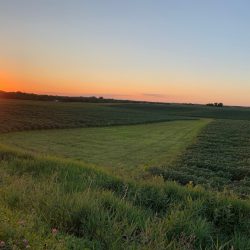 Nancy and Matt Bormann from Kossuth County have their fingers crossed that the rest of the growing season goes as well as planting. Thanks to a great stretch of weather, everything but the seed corn was planted in an eight-day stretch in late April and early May.
Nancy and Matt Bormann from Kossuth County have their fingers crossed that the rest of the growing season goes as well as planting. Thanks to a great stretch of weather, everything but the seed corn was planted in an eight-day stretch in late April and early May.
Planting soybeans into the cover crop worked great. “We went right into the green standing rye and then terminated it that day or the day after. All of our soybeans germinated fine,” Nancy said.
They’ve also managed to stay up to speed with their nutrient management. They use split nitrogen applications, and crops that needed another application have been side-dressed.
Matt says a current challenge, for many in their area, is waterhemp. In years when pre-emergence herbicide activation is a challenge, a thick mat of rye can help suppress weeds. “Cover crops provide a tool for weed control,” he said.

Several different methods were evaluated for establishing cover crops. One they’ve found to work is having rye seed applied with their dry fertilizer, followed by a light vertical-till. “We’re going to spread P and K anyway, so we checked and our agronomic supplier was able to source and apply the seed for us with that application,” Nancy said.
They’d like to expand cover crops beyond their seed corn acres and are hopeful the early start this spring leads to an early harvest, and the opportunity to cover more acres this fall.
The Bormanns are also proponents of the strip-till system they’ve adopted. “We pattern-tiled a field so it was field cultivated instead of strip-tilled. We worked it several times to try to get it leveled out,” Matt said. “Right across the road was a strip-tilled field of the same hybrid. Late June we had a wind event and the corn in the conventionally tilled field did not stand near as well. We really feel the strip-till corn has a better root structure.”

Thanks to timely planting and rains, Matt believes there is at least near-average, and possibly above-average, yield potential compared to their farm average. He also believes 4R Plus practices used on the farm help keep soil productive.
Nancy, a Certified Crop Adviser, urges farmers to take the first step or expand adoption of specific 4R Plus practices like cover crops, strip-till or nitrogen inhibitors. “There are several different programs and also incentives for certain watersheds. You might be able to get a little boost for trying out some conservation practices for your farm,” she said.
Matt vigorously reinforces the need to take action. “There are a lot of things going on big picture right now that we can’t control as farmers, but we can make our soil better, and that’s important,” he said. “We can change practices and use cover crops and tillage systems to improve our soil and reduce chemical and fertilizer costs. Now is the time to focus on the things we can do to make a positive outcome in the big picture.
“I’m encouraged. More farmers are asking us about our 4R Plus approach,” he said. “Especially with the benefits we see on our farm, and with help available, I can’t think of a good excuse not to at least try a new conservation or nutrient management practice.”
Click here to ask Matt and Nancy a question about their farming operation.
